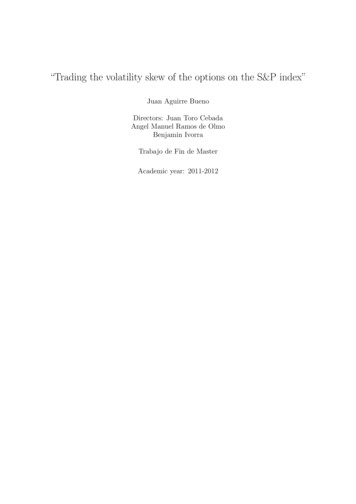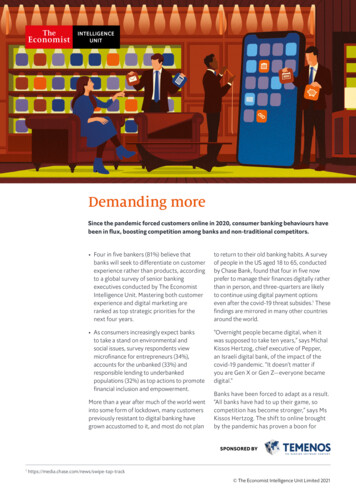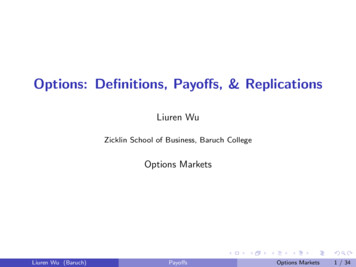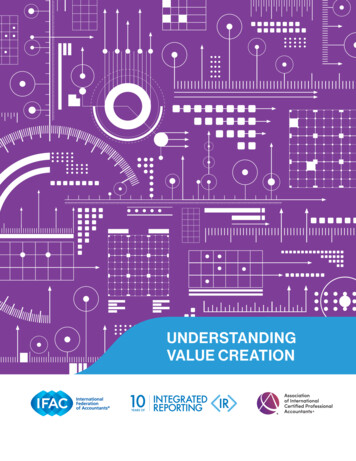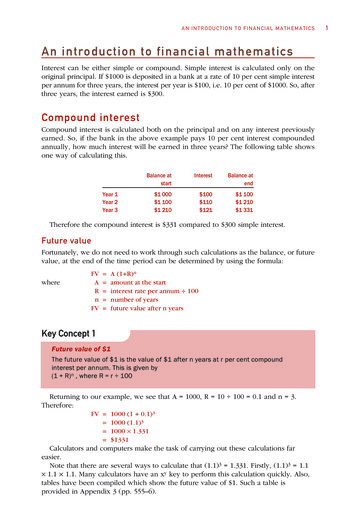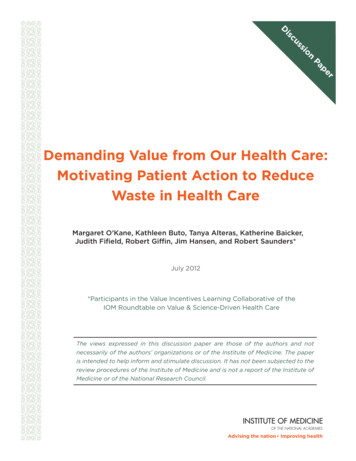
Transcription
cisDonsiusrpePaDemanding Value from Our Health Care:Motivating Patient Action to ReduceWaste in Health CareMargaret O’Kane, Kathleen Buto, Tanya Alteras, Katherine Baicker,Judith Fifield, Robert Giffin, Jim Hansen, and Robert Saunders*July 2012*Participants in the Value Incentives Learning Collaborative of theIOM Roundtable on Value & Science-Driven Health CareThe views expressed in this discussion paper are those of the authors and notnecessarily of the authors’ organizations or of the Institute of Medicine. The paperis intended to help inform and stimulate discussion. It has not been subjected to thereview procedures of the Institute of Medicine and is not a report of the Institute ofMedicine or of the National Research Council.Advising the nation Improving health
AUTHORSMargaret O’KanePresident and CEONational Committee for Quality AssuranceKathleen ButoVP, Health Policy & Government AffairsJohnson & JohnsonTanya AlterasAssociate Director, Consumer-PurchaserDisclosure ProjectNational Partnership for Women & FamiliesKatherine BaickerProfessor of Health EconomicsHarvard UniversityJudith FifieldDirector, Center for Translating Researchinto Practice and PolicyUniversity of Connecticut Health CenterRobert GiffinVP, Healthcare Policy & ReimbursementCovidienJim HansenVP & Executive DirectorDossia ConsortiumRobert SaundersProgram OfficerInstitute of MedicineThe authors were assisted by the following individuals:Charles AlstonMSL WashingtonLorainne GlazarTMC HealthCareValerie RohrbachInstitute of MedicineDavid AschUniversity of PennsylvaniaJudith HibbardUniversity of OregonSusan ShurinNational Institutes of HealthLeah BinderThe Leapfrog GroupSheri McCoyJohnson & Johnson (formerly)Kevin VolppUniversity of PennsylvaniaDavid CliffordPatientsLikeMe (formerly)Brian PowersInstitute of MedicineBenjamin WeigandJohnson & JohnsonAlexandra ClydeMedtronicLygeia RicciardiOffice of the National Coordinator forHealth Information TechnologyExplanation of contents: The following discussion paper includes two appendixes that areintended as companion and complementary items to the main text. They can also be used aspull-out, standalone resources for a variety of audiences.This discussion paper can be accessed at: www.iom.edu/PatientsForValue.
Demanding Value from Our Health Care:Motivating Patient Action to Reduce Waste in Health CareMargaret O’Kane, National Committee for Quality Assurance; Kathleen Buto, Johnson &Johnson; Tanya Alteras, National Partnership for Women & Families; Katherine Baicker,Harvard University; Judith Fifield, University of Connecticut; Robert Giffin, Covidien;Jim Hansen, Dossia; and Robert Saunders, Institute of Medicine1Health care costs have doubled as a share of the economy over the past three decades(Martin et al., 2012), causing stress on family, employer, and government budgets. Furthermore,these expenses contain substantial waste and often do not improve patient health. One importantway to improve this situation is by engaging patients and the public around value. There arenumerous challenges to achieving this goal, including several unanswered questions about howbest to routinely approach patients on the issue. Yet, some insights are developing. First, thesuccess of value initiatives depends on their understanding of, and connection to, patient goals,motivations, values, and aspirations. To further engage people around value requires thatcomparative cost and quality information is available and comprehensive enough to supportindividuals’ care decisions. Finally, value needs to be embedded in all aspects of health caredecisions—from incentives to benefit design—to support patients and consumers as they seek toincrease the value they achieve from their care. Given the size of the task, effective change willrequire coordinated efforts from all stakeholder groups.WHY IS IT IMPORTANT TO ENGAGE PEOPLE IN HEALTH CARE VALUE?In recent years, concerns have been growing about the rising cost of health care. In 2012,health care will consume an estimated 18 percent of the economy, or almost 2.8 trillion.Moreover, costs are increasing rapidly, having risen by 88 percent in the last decade (Martin etal., 2012). These rising costs stress family, employer, and national budgets. Rising health carecosts have eaten away at income gains for the last decade, leaving a family’s real wagesessentially flat. In the same time frame, insurance premiums for families and individuals havemore than doubled (Auerbach and Kellermann, 2011). These cost problems can be quite acutefor those struggling with serious medical conditions, with 40 percent of such patients reportingthat health care costs are a serious financial problem for them or their families (NPR, RWJF, andHarvard, 2012). If this type of spending produced outstanding results, it could potentially bejustified. However, the health care system contains substantial waste that does not improvepatient health and produces little value.Greater engagement of patients and the public has the potential to transform everydimension of health care. This is especially true for improving health care value. Focusing care1Participants in the Value Incentives Learning Collaborative of the IOM Roundtable on Value & Science-DrivenHealth Care. While the manuscript reflects contributions from the authors, authorship does not imply endorsementof every point expressed in the document. In addition, although the individuals who provided assistance submittedmany constructive comments and suggestions, they were not asked to endorse the final draft of the discussion paperbefore its release.Copyright 2012 by the National Academy of Sciences. All rights reserved.1
on patient needs can promote higher-quality care and better use of resources, which has beendemonstrated in several prior studies. For example, several studies have found that patientcentered communication is associated with fewer diagnostic tests and lower costs (Epstein et al.,2005). Another study found lower use of health care services and lower overall cost withphysicians who employ a patient-centered practice style (Bertakis and Azari, 2011).Furthermore, studies of shared decision making have found that patients who receive thoroughinformation on benefits and risks tend to choose less-invasive treatments; one study found thatwell-informed patients were 20 percent less likely to choose surgery than other patients(O’Connor et al., 2009; Stacey et al., 2011). These examples demonstrate the impact that patientsand consumers can have on improving health care value when they are involved in their owncare.Patients and consumers may be increasingly receptive to beginning a conversation aboutvalue. While most Americans are generally happy with their specific coverage and care, mostalso see the need for improvements to the overall system (Blendon et al., 2011; RWJF, 2011).For example, 65 percent of Americans grade the quality of their care as an A or a B;approximately the same percent rate the overall quality of American health care as grade C orbelow (Blendon et al., 2011). Moreover, changes in the structure of health insurance, such as theshift toward high-deductible health plans, have increased the level of costs borne directly bypatients and consumers. In 2010, 30 percent of workers had an individual deductible of 1,000 orhigher for their employer-sponsored insurance (KFF and HRET, 2011). On a national level,policy discussions have begun to focus on defined-contribution plans, like premium support andvouchers, amid growing anxiety about the ability to control ever-rising health care costs (Haskinset al., 2011).Another opportunity to engage people in value lies in the growing interest in, and abilityof the public to look for, information that can guide their decisions in many aspects of their lives.In a recent survey, almost 60 percent of individuals were willing and able to do detailed researchbefore buying a car, and 50 percent do so before buying a major appliance (Lynch and Smith,2011). While decisions in health care are different from decisions about consumer goods, thereare some similar principles at play. Accordingly, there are signs that consumers are increasinglylooking for health care information. In 2011, 80 percent of Internet users looked online for sometype of health information (Fox, 2011). Before a doctor’s visit, patients are looking forinformation to help them better explain their symptoms, while after the doctor’s visit, they arelooking for information to better explain what the doctor said and alternative treatment options.People’s growing interest in accessing health information presents a new opportunity forengaging conversations around value.While certain initiatives have reported success in involving people in improving healthcare value, more work needs to be done to understand how to engage patients consistently.Several themes are beginning to emerge from research and practice on strategies forcommunicating and discussing value and applying those insights to care decisions. This paperhighlights key lessons learned about engaging people in value: the need to understand whatpatients view as value; the need to ensure the availability, utility, and use of cost and qualityinformation; and the need to provide more than just information to support patient valuedecisions. These lessons can be the basis for the continuing work that needs to be done.Further information about ways to engage patients in value is included in Appendix A,which summarizes this information in short document intended for broad accessibility. Appendix2
B contains selected resources that have been developed on care cost, quality, and value forpatient and consumer decision making.WHAT ARE THE KEY CHALLENGES IN INVOLVING PEOPLEIN HEALTH CARE VALUE?Given the unsustainable path of growth in health costs, attention needs to be focused onimproving health care value. Fundamentally, value is what is gained for a given cost. Yet, thissimple definition is complicated by the fact that different stakeholders have differentperspectives on what procedures, treatments, technologies, and care practices are valuable andhow valuable they are (IOM, 2010). Given the importance of patient perspectives in the healthcare system, definitions of value should consider how care improves patients’ overall health,their quality of life, their experience of care, and the overall health of the public.One challenge is that many patients and consumers are reluctant to talk about value(Hibbard and Sofaer, 2010; RWJF, 2011). In some cases, value can be perceived as a code wordfor rationing, implying that care may be cheapened or that patients would have less time withtheir clinicians (RWJF, 2011). These perceptions translate into tepid support for incentives thatencourage people to consider value when selecting clinicians, health care organizations, ormedical treatments.Another challenge is that many individuals are unsure about the usefulness of detailedresearch into health care options. One survey found that 40 percent of people were uncertain thatthey could find a better-qualified doctor through detailed research while 60 percent were notconfident that they could reduce the cost of health care by shopping around (Lynch and Smith,2011). Part of the reason that many individuals believe research will not improve their healthcare options is the common perception that all hospitals or clinicians are of similar quality—oreven that all health care meets minimum quality standards (Blendon et al., 2011; Carman et al.,2010; Hibbard and Sofaer, 2010; KFF, 2008, 2011). If quality does not vary, there is little to begained by careful research of different health care options. Yet, multiple studies have shown thatwide differences exist in the quality of care delivered by different hospitals and physicians.These quality differences occur independently of cost—sometimes better-quality care cost more,but often it costs less.Several other challenges exist when seeking to engage patients in health care value.Unlike the decision to purchase a consumer good, health care decisions can be made under verydifficult circumstances when patients are under physical, mental, and emotional stress. It isunlikely that an individual suffering a heart attack is going to research hospitals while in anambulance. In addition, patients vary in their need to make major health decisions. In a givenyear, most people will use few health care services—in 2008, half of the population accountedfor 3.1 percent of the total health care costs (Cohen and Yu, 2011). On the other hand, patientswho deal with chronic diseases like diabetes or high blood pressure will continue to struggle withtheir disease for years or decades and will need to devote ongoing attention to managing theseconditions. These patients will respond differently to incentives and may have different views onhealth care value than a patient facing an acute health care condition (Loewenstein et al., 2012).Finally, making decisions about value can be very difficult and therefore is only done by themost engaged and motivated patients (Hibbard and Sofaer, 2010). Understanding the challengespatients face is fundamental to promoting engagement in health care value.3
One Patient’s Struggle to Find a PhysicianMr. A, a previously healthy 37-year-old man, suffered a heart attack 3 years ago and wasdiagnosed with several unusual cardiac conditions. He developed a relationship with acardiologist at a large health center in his area and appreciated his physician’s attention toadverse effects from medication. In the spring of 2009, Mr. A’s cardiologist moved to anotherarea, requiring him to select a new clinician for his care. As he looked for a new physician, hecouldn’t find the information he wanted. He disliked the top physician lists, feeling that theyweren’t asking the questions he cared about, and struggled to find basic information on many ofthe cardiologists in his area. Further, as his conditions were unusual, he questioned whether thegeneral findings reported on many websites would actually apply to someone like him. His storyhighlights the issues that many patients have in learning about potential clinicians and the needto customize information to different patients.SOURCE: Howell, 2009FIRST LESSON LEARNED: UNDERSTAND WHAT PATIENTS VIEW AS VALUEOne important lesson is that the success of value initiatives depends on theirunderstanding of, and connection to, patient goals, motivations, values, and aspirations (Rollnicket al., 2008). A person’s internal motivations can be a powerful resource for long-term change(Wiegand, 2011). This underlines the importance of discovering a patient’s goals and how theyfit into the value discussion.Misconceptions often exist about what patients view as value. In seeking to improve thepatient-centeredness of care, some health care organizations and providers have focused onaspects such as food and hotel-like amenities (Rau, 2011). Yet, previous studies have found thatsubstantial differences often exist between the factors providers believe are important to peopleand the factors patients identify as valuable (Hibbard and Sofaer, 2010). Summaries of thisresearch have found that patients value many aspects of their care, including technicalperformance but also including other factors (Bechtel and Ness, 2010). The factors patientsconsider when evaluating health care can be categorized into the following groups:Patient-centeredness;Affordability and accessibility;Communication and information;Courtesy and emotional support (from all members of staff);Efficiency in the use of patients’ time with good coordination between all care elements;High technical quality; andStructure and facilities in which care is delivered (Sofaer and Firminger, 2005).One theme that consistently runs through these categories is that people value a personalrelationship with their clinician (RWJF, 2011). Individuals prefer a continuous relationship withsomeone who knows about them as a person, understands their history, and communicates withthem. This type of patient-centered relationship also has been associated with positive health4
outcomes. In one study, HIV patients who felt that their provider knew them as a person weremore likely to take antiretroviral therapy, adhere to that treatment, and have better outcomes(Beach et al., 2006).Another area that patients consider in their value calculus is whether their doctor stays upto date with the latest medical evidence. Focus group research has found that patients aregenerally supportive of medical evidence and efforts to identify the treatments that produce thebest results for patients. However, research also shows that patients can become concerned aboutmedical evidence if it is seen as limiting their options, since more care, especially newer care,can be perceived as better. Further, consumers may believe that evidence-based guidelines onlyapply to the average patient and are inflexible (Carman et al., 2010). Patients, therefore, weighthe interaction between options, new knowledge, and customization to their condition in decidingthe value of new medical evidence.Beyond value in medical care, there are emerging lessons about what consumers value inhealth insurance plans. Focus groups have found that consumers do not define value in healthinsurance based solely on price. Rather, consumers also account for a plan’s covered medicalservices and how much they would pay out of pocket for those services (Quincy, 2012).Yet, patients are not homogeneous in their views. Opinions about value vary from state tostate, from town to town, and from individual to individual. As recognized by the concept ofshared decision making, the right answer for a given patient depends on his or her personalcharacteristics, values and goals, and support networks.SECOND LESSON LEARNED: MAKE SURE THE BEST INFORMATIONIS EASY TO FIND AND USEAnother important lesson in engaging patients in value is that comparative cost andquality information should be available and comprehensive enough to support individuals’ caredecisions. Too often, beyond anecdotes and stories, individuals have little trusted informationthat they can use to make decisions. Even among patients who are engaged, it is frequentlyunclear where to go for reliable sources of information about their providers, hospitals, or healthplans (Howell, 2009).Current cost- and quality- reporting efforts have gained limited traction with the public—few people know about them, and fewer use them in making decisions (Fung et al., 2008; KFF,2008; Lynch and Smith, 2011). One survey found that approximately 14 percent of respondentsnoted that they had seen and used information comparing the quality of different health insuranceplans, doctors, or hospitals (KFF, 2008), while another found that less than 30 percent ofindividuals research potential physicians (Lynch and Smith, 2011).Challenges in Applying Information to CareOne reason for the limited use of reported information is that information is routinelypresented in a way that is not meaningful to people. Complex information that cannot be appliedeasily to an individual’s health care situation will not be used (Hibbard and Sofaer, 2010;Hibbard et al., 2012; Hibbard and Peters, 2003; Shaller Consulting, 2006; Vaiana and McGlynn,2002). The presentation of the information may be as important as the information itself—thecontext, language, graphics, and format of information help people use it easily (Hibbard andSofaer, 2010; Vaiana and McGlynn, 2002).5
Several factors can affect whether people use reported information, such as whether theyhave multiple health care options in their geographic area, whether financial incentivesencourage patients to seek high-value providers or health care organizations, and whether theirphysicians or family recommend a particular provider (Blendon et al., 2011; KFF, 2011; Lynchand Smith, 2011; Sinaiko, 2011; Sinaiko and Rosenthal, 2011; Tu and Lauer, 2009). Anotherfactor is the salience of the presentation; statistics may not be as powerful as anecdotes orpersonal examples when individuals are making health care decisions (RWJF, 2010). One studyfound that patients presented with statistical information made different decisions than thosepresented with statistical information and a single contradictory anecdote—the number ofpatients choosing a given treatment dropped by 20 percentage points when they were given ananecdote that contradicted the statistics (Fagerlin et al., 2005). This highlights the need to deliverinformation in a way that resonates with people’s goals and preferences.There are specific concerns when information is presented online. Given the ubiquity ofthe Internet as an information source, more health care value information is increasinglypresented there. Online information is of varying quality and comprehensiveness, ranging frombasic consumer reviews—where patients write about their experiences—to complex sites withobjective quality and value measures which can present very technical material. Given howcommon review sites are in other aspects of everyday life, it is likely that their prevalence inhealth care is going to increase over time.In considering online information, it is important to recognize that people from differentage groups have differing interest in using online information sources for health care decisions(Lynch and Smith, 2011). When considering how to display cost and quality information online,there are several best practices gained from focus group and survey research. First, a simple,uncluttered format with easily understandable information tends to be preferred by most people.All terms should be explained clearly, especially those whose meaning depends on one’sperspective. Second, building trust is important as conflicts of interest are a common concern—individuals want to know the source of information as well as the sponsors who providedfinancial support (RWJF, 2010).Another factor that influences people’s use of health information is the complexity of theinformation and the technical language used to describe health care options, from health plans totreatments. Understanding the terminology and concepts needed to make value decisions can bedaunting, especially when that information is presented in complex and lengthy documents.These problems are compounded for the nearly half of all American adults with lower rates ofhealth literacy (IOM, 2004). Even for those with higher levels of health literacy, focus groupresearch finds that common health benefit terms—like deductible, co-insurance, and out-ofpocket limits—can be difficult to apply, making comparison shopping and informed selectiondifficult for consumers (IOM, 2012; Quincy, 2012).In the specific case of providing cost and price information, several considerations arerelevant. Without useful information about quality, consumers can equate higher cost with higherquality (Hibbard et al., 2012; Mehrotra et al., 2012). For example, one survey of Californiaresidents found that 35 percent believed higher price was associated with better care, while 65percent assumed the care was probably about the same, regardless of price (Shannon, 2011). Ifthis perception leads more people to seek high-cost providers, then cost reports without qualityinformation have the potential to increase costs. To prevent this problem from occurring, costinformation needs to be meaningfully integrated with information about the quality of health careservices and providers to highlight that higher-quality care can be delivered at lower cost6
(Carman et al., 2010; Hibbard and Sofaer, 2010; Hibbard et al., 2012; Mehrotra et al., 2012;Sinaiko and Rosenthal, 2011).When providing price and cost information, many patients and consumers are specificallyinterested in their estimated out-of-pocket cost. Yet, several factors make it difficult to provideestimates of out-of-pocket costs. It is rarely known what health care services are needed for aspecific health condition; each health plan tends to use a different benefit structure with differentlevels of cost sharing; and the negotiated rates for services are rarely disclosed for proprietary,antitrust, or contractual reasons. As an example, in a Government Accountability Office surveyof 19 Colorado hospitals, none was able to provide a complete estimate of the consumer’s costfor a full knee replacement (GAO, 2011). Without such basic information, people have littleability to seek better value.Finding the Price of CareFinding the price of a particular treatment or test can be very difficult. Brad, a studentfrom North Carolina, experienced this problem after developing a sinus infection. As Brad had ahigh-deductible, catastrophic insurance policy that covered only four physician visits a year, hewas very concerned about the cost of treating this condition. His physician prescribed lab workand a CT scan, but Brad knew that his insurance would not cover the CT scan. At first, he askedadmissions for the price. Admissions didn’t know, so they called the imaging department, whichalso didn’t know. Finally, admissions found the price of a sinus CT scan ( 900) in a little-usedblack binder. Brad declined the CT scan, but went to the lab. Unfortunately, his physician hadreferred Brad to a lab that was out of network for his insurance. A month later, he received a billfor 478. Brad learned that when looking for medical care, even routine services, finding the costof care is frequently the biggest challenge.SOURCE: Shah, 2010Strategies for SuccessThese factors speak to the need to simplify information to highlight what the consumerneeds to know, when they need to know it (Quincy, 2011; RWJF, 2011). To be useful fordecision making, information must be available just in time, immediately understandable, andapplicable to the health care situation under consideration. A study of 70 health plan report cardsconcluded that the most useful report cards presented information in a form that consumers couldunderstand at a glance and then explore more deeply if interested (Cronin, 2011). Meeting thisgoal often requires involving people in the design of reporting schemes to understand theirpreferences and needs (Bechtel and Ness, 2010; Quincy, 2012; Shaller Consulting, 2006).Several other industries outside of health care have developed sophisticated methods fortranslating complex information to a public audience in a format that can be used for decisionmaking. These methods can provide inspiration for new health care communication strategiesthat are usable and accessible to patients and the public.7
Customizing Messages Increases TheirPotential UsefulnessWhile information is important in itself, the more customized the information is to aparticular patient, the more likely it is to be used. As an example, one study looked at how likelypatients were to take a particular cholesterol medication (a statin). Some patients were given ageneric guide to cholesterol, while others received feedback customized to their knowledgeabout cholesterol, their beliefs and values, and the barriers they identified to taking a medication.At the end of 6 months, 70 percent of the patients who received the more customized messageswere still taking their medication, compared to 61 percent of those who received genericmaterials.While this is a clinical example, the same principle is true for information about value.Adapting the message to an individual’s beliefs, knowledge, and goals will be more likely tosucceed than offering generic information.SOURCE: Stacy et al., 2009As different populations have different needs, preferences, and abilities, strategiescustomized to meet those needs are more likely to succeed (Kling et al., 2008; RWJF, 2011;Wiegand, 2011). People vary in their ability to manage their health, the family and communityresources they can draw upon for their care, and their motivations and interest to be involved intheir care. Some people, including those struggling with serious conditions, are very wellinformed about their care options, follow clinical research, and play an active role in their care.Those patients taking an active role in their care will have different information needs (andrespond to information differently) than less-engaged patients (Hibbard and Cunninghan, 2008;Hibbard et al., 2004). To engage individuals who are currently less activated in health care,initiatives may need to encourage small steps, start where people are, and measure and assesstheir progress (Hibbard and Tusler, 2007).Another opportunity for expanding the availability of value information is by involvingclinicians in this effort. Clinicians are trusted sources of information for many patients, andpeople often turn to them for help in making decisions. As such, their involvement is critical inmoving toward increased patient engagement. However, those clinicians, often in primary care,many times lack the information they need to help their patients with value decisions. Althoughsuch discussions require substantial time and effort, clinicians receive few incentives forundertaking these important conversations. In addition, clinicians have few practical tools at theirdisposal for discussing value with their patients, further limiting their ability to engage in theseefforts.Similarly, families and caregivers can play an important role in discussing value withpatients. Families, friends, and caregivers are a key source of information that people use inmaking decisions. People often value the recommendations or opinions of friends and familyover objective data about the quality of providers (Sinaiko, 2011). Further, families andcaregivers can play an important role in decision making, from choosing what clinicians to visit8
to selecting treatments and scheduling physician visits. As such, they also need to be involved invalue conversation
before buying a car, and 50 percent do so before buying a major appliance (Lynch and Smith, 2011). While decisions in health care are different from decisions about consumer goods, there are some similar principles at play. Accordingly, there are signs that consumers are increasingly looking for health care information.


